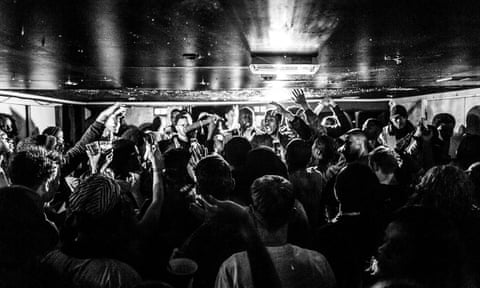Mektoub, My Love: Intermezzo
There have been many notable nightclubs in film history. The Blue Angel in the Marlene Dietrich movie; the Copacabana in Goodfellas, accessible to privileged wiseguys via the kitchen; the Slow Club in Blue Velvet, with the emotionally damaged star turn Isabella Rossellini singing the song of the same name.
But the most staggering nightclub scene has to be in the 2019 film Mektoub, My Love: Intermezzo, by the prize-winning director Abdellatif Kechiche. It is a sequel to an earlier film, about sexually charged goings-on in the French seaside town of Sète.
This film lasts for three and a half hours. It has, in effect, just two scenes. The first lasts for half an hour, showing the cast hanging out on the beach. Then there is the nightclub scene, unfolding over a mind-pulverising, brain-twerkingly bizarre three hours, interrupted by a full-on 13-minute sex scene in the toilets – after which the participants return insouciantly to the dancefloor.
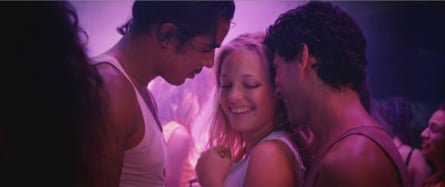
Is it an immersive, surrealist cine-installation on the subject of hedonism, clubbing and sexiness with zero emotional engagement between the audience and the characters or the characters and each other? Or is it an example of a director having a sex-obsessed midlife breakdown on screen?
Watching it is a bizarre experience. I saw it at Cannes and I don’t think it has been shown again; there was no DVD release. But it features the craziest nightclub scene in movie history. Peter Bradshaw, Guardian film critic
Ewen Spencer’s photographs
I was born in the 90s, in the belly of the beast that was rave culture, and the garage and jungle movements in the UK. There was something incredible and exciting about watching my mother and her friends get dressed up and ready for a night out: feathers, cowboy hats, Burberry skirts, whistles and crop tops galore. It made me want to click my heels three times and suddenly be twentysomething, so that I could go with them.
The photographer Ewen Spencer captured these Fomo-creating moments in time. They can never be replicated. You can feel the vibrations of the bass; you can smell the sweat and the hair gel. They show the way that fashion and rave culture held hands and danced together throughout an era of club culture. Tiffany Calver, DJ and broadcaster
Before You Were Mine by Carol Ann Duffy
Has the thrill of the dancefloor ever been more succinctly and sensuously evoked than in Carol Ann Duffy’s great poem of filial love? It imagines her teenage mother sneaking out to clubs in Glasgow and Edinburgh with her pals in the 50s. “I’m not here yet,” she writes. “The thought of me doesn’t occur in the ballroom with the thousand eyes … where you sparkle and waltz and laugh before you were mine.”
She might be a wee stop-out, in for a hiding when she gets home – “And whose small bites on your neck, sweetheart?” – but beneath a glitterball, in her red high-heeled shoes and her polka-dot dress, she will always be Marilyn Monroe to her daughter. It is a romance familiar to anyone who clumped around in their mother’s stilettos or stuck their nose in her makeup box to inhale the glamour. Claire Armitstead, Guardian associate culture editor
The Great Beauty and Northern Soul
I love the party scene in Paolo Sorrentino’s The Great Beauty that introduces the lead character, a bit of a Larry David type – it is hyperreal, like the Hacienda and Fellini mixed together. I love the mixture of people in that party, all generations, all kinds of stories inside the scene: the kind of party I like to be at. The music is cheesy and bouncy, but it is right for the scene in the end: the emptiness of all this, that feeling of finding yourself in the midst of the hedonism and loving it, but knowing underneath that it doesn’t fulfil everything. The more you get, the more you want.
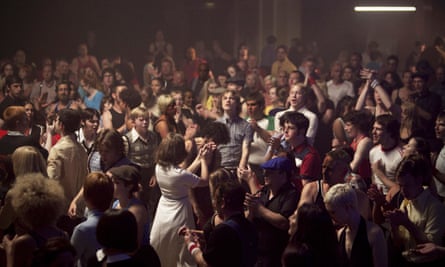
It is virtually impossible to create a real club scene within a film. Almost all films that have tried to do it have failed. It is even more of an uphill battle when you have a scene that you are trying to recreate from the past: you can’t just get a load of Instagram posers and stick them into a club scene that is based 20 years ago.
The problem Elaine Constantine had when trying to bring her film Northern Soul together – and when she made my video for Familiar Feeling, which is also about a northern soul night – is that everyone who could do the dancing and knew the scene was fucking ancient. So she found a load of teenagers who were interested in it and did classes once or twice a week for three years where she taught them to dance. They got really into the music as well and got to understand what the whole thing was about, then she shot the film. That is why the film has the most authentic and beautiful dancefloor scenes you will ever see in any film – I haven’t seen anything better.
A few years ago, for the music I made with Maurice Fulton, I shot three videos in one space over a few days and I invited people through social media to be in them. I was explaining all the time: you’ve got to not look at the camera, continue drinking your drinks, talk to each other while you’re dancing. And it was still tricky to stop them – every time the camera came by, they would try to get in the place of the camera and show off. That was the antithesis of what I was trying to create. I just had to keep shouting down this funnel thing: you’re off your heads! It looks like mayhem, but it’s actually really organised, in order to stop it looking like stage school kids pretending to be in a rave. Róisín Murphy, dance musician
Hitman 3
Clubs tend to be sleazy places in video games, a kind of childish shorthand for mature content that is, in fact, decidedly immature – think Duke Nukem’s embarrassing strip joints. But when IO Interactive’s Hitman 3 sends us to a Berlin nightclub in an abandoned industrial warehouse on the edge of a wood, it feels less like posturing and more like tourism.
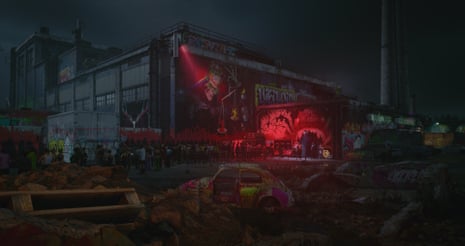
Once you have figured out how to get into Club Hölle, a process only slightly more involved than getting into Berghain in real life, you descend slowly into a sunken dancefloor so packed with bodies that you can almost smell it. You can spend as much time as you like longingly exploring the scuzzy bathrooms, hidden bars and outdoor chillout zones, or spend 20 minutes raving by yourself on the couch while watching the virtual DJ and trying to remember what real fun felt like. The only thing that breaks the atmosphere is the inexplicably American-accented voice acting. Keza MacDonald, Guardian video games editor
The Terminator
In the nightclub scene, the Terminator is looking for Sarah Connor, who has been identified for termination because of the role she will play in the resistance against the machines in the future. It takes place at a club called Tech Noir. Along with Connor is Kyle Reese, sent from the future to protect her.

I was deep into new wave growing up as a teenager in the early 80s, listening to Human League, Depeche Mode, Gary Numan, Soft Cell, the B-52s, OMD; there was a new wave club I used to go to in Detroit called Club Liedernot. The atmosphere in Tech Noir is very authentic – it absolutely, completely nailed it. The music they were playing, the clothes, the dance moves, the way the bar was set up, the neon lights. It didn’t seem like they were emulating something, which is very hard to do – to create something that real.
The Terminator shows up at the nightclub, spots Connor and immediately draws his weapon. Reese notices, shots are fired and the club is cleared out. It is really indicative of what coronavirus is. It is like the Terminator: it doesn’t care what religion you are, what political affiliation you are, black, white, whatever. It is stalking everybody. My mother died of cancer and her funeral was restricted by the virus. Two of my uncles passed away from Covid. And dealing with the whole George Floyd situation … It was a dark cloud, with one cloud being coronavirus and the other cloud being hate. There are many instances of disease and pestilence in society and it can be depressing.
I am not able to play to an audience and just release, have some kind of escapism or provide escape to an audience that just wants to get away for a time and lose themselves in the music.
You can also look at the Terminator as how a plague of social media and technology has taken us over. We don’t know how to stop it. Look at the rise of Donald Trump and how he used Twitter to attack people instead of bringing people together. The Terminator is kind of prophetic – this is a film from 1984 and look at where we are now. Robert Hood, DJ and producer
Ms Dynamite

I particularly remember, at the height of the UK garage surge in the early 00s, the video to Ms Dynamite’s song Booo!, produced by Sticky. It’s in a club setting and someone announces her before she gets on stage, so the crowd are full of anticipation and rowdy. Then everyone starts booing. It was the antithesis to what I would have expected – normally if someone boos, you’re surely not doing something right, but it was slang, it was culture: shouting “Booo!” means it’s good! Being really young at that time, it set the scene for me for what raves and clubs would be like.
There were other trends, like encouraging the DJ to rewind the track so that he started again from the top – Craig David and the Artful Dodger captured that in their music video for Re-Rewind and helped establish it. Another example was seeing a video of General Levy performing at Brixton carnival, with everyone moshing everywhere and him being like: “Wheel it up, we have to start that all again.” That energy translated so strongly through the screen.
Dub culture transcends through these different hybrids of black British music and videos create and perpetuate a visual template of what transpires when this music is played. They build up the excitement to really get into that environment and connect to crowds of people. I couldn’t wait to get out to a club, put my gun fingers up and go mad. Karen Nyame KG, DJ and producer
Two Lovers
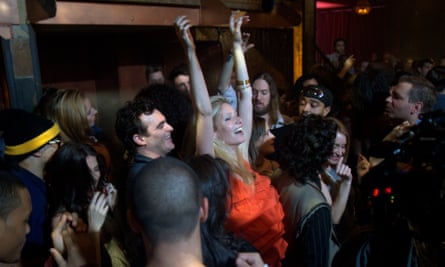
Michelle (Gwyneth Paltrow) has invited her troubled new neighbour, Leonard (Joaquin Phoenix), for a night out. Leonard takes Michelle by the hand and leads her down a flight of stairs to the edge of a packed dancefloor. Buoyed by cheap vodka (downed in the taxi en route) and Moby’s house track I Love to Move in Here, Leonard shimmies his shoulders, allowing his worries to slide off. He does the worm and the camera dives woozily between the other partygoers. Michelle, delighted, spins her way towards him, the ruffled tiers of her chiffon vest exaggerating the movement.
The two and a half minute scene is a rare bright moment in James Gray’s 2008 film Two Lovers, an otherwise sombre romantic drama set in the Brooklyn neighbourhood of Brighton Beach. Untethered from the aspirational mythos of the city, the club has a suburban feel. It is not flashy or glamorous, but it is not exactly gritty, either. Seeing A-listers letting loose is a reminder that feeling free is for everyone. Simran Hans, Observer film critic
Victoria
There is a paradoxical feeling of communality and isolation in the best club experiences, where everyone is rhythmically undulating to the same tune, but also taking solace in the darkness of the dancefloor. It is difficult to capture, but the opening of the 2015 single-shot thriller Victoria gets about as close as possible.
DJ Koze’s Burn With Me rumbles as an unfocused shot weaves through a strobe-lit crowd – busy, but with space to move – settling on our heroine in the midst of that peaceful yet kinetic inner dance. You can almost feel the heat off the surrounding bodies as they cheer in unison to the crack of the snares kicking in – and then she leaves. In only a minute, the sequence conjures that harmony of movement, sound and selfhood. Ammar Kalia, Guardian global music critic
Part of the Weekend Never Dies
Ostensibly a rockumentary about Soulwax, Saam Farahmand’s film doubles as a love letter to live gigs in all their sweaty glory. The scenes, cut from more than 100 of the group’s live performances, are anarchic, the camera panning across stages to capture band members and audiences drenched in strobe light.
That alone is a bittersweet reminder of how good live music can be, but the best part of the film is the toilet scenes, where punters talk between themselves and sometimes directly into a camera set up in the stalls. They gossip, sum up their evenings and – for the most part – talk nonsense. As good as gigs are, the real thing I miss the most is those messy moments – shouting into someone’s ear about a band you have heard about, or the after-hours sessions where you put the world to rights. Lanre Bakare, Guardian culture reporter
Crowd
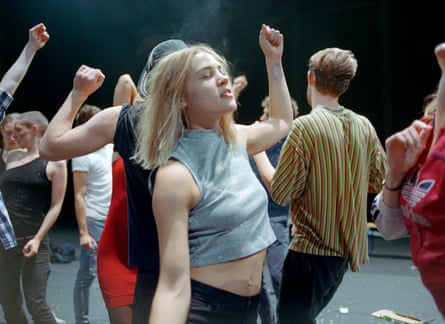
Gisèle Vienne’s 2017 dance piece Crowd is like a 90-minute trip down a K-hole. Inspired by the Franco-Austrian choreographer’s teenage years clubbing in Berlin, going to squat parties and the legendary nightclub Tresor, Crowd is a portrait of young people seeking euphoria and finding their religion in repetitive beats. With cigarettes, beer cans and an expectant buzz of what the night may bring, Crowd has earth and empty water bottles strewn across the stage, Jeff Mills and DJ Rolando pulsing from the speakers, the dancers’ tracksuit layers discarded as the heat rises.
The wild freedom of a rave is designed in forensic detail as Vienne warps the sense of time with freeze frames, loops and eerie slow motion. We see fleeting bursts of intimacy and antagonism in myriad micronarratives, the way a night out can be monumental in the moment and a hazy figment the next day. It makes for hypnotic viewing. Lyndsey Winship, Guardian dance critic
The Sparsholt Affair by Alan Hollinghurst
You don’t come to the novels of the Booker prize winner Alan Hollinghurst looking for an innate understanding of the conjunction of dance music and MDMA. But towards the end of 2017’s superb The Sparsholt Affair, there is a scene set in a gay club. The context doesn’t matter, nor the denouement: what does is how perfectly Hollinghurst’s writing captures the giddy confusion of a wide-eyed night on the dancefloor.
He doesn’t bother with specifics about music, instead managing to pin down the hardest thing of all – the feeling of chemically enhanced, musically driven transcendence – in prose that veers between elegance and something approaching a stream of consciousness. “He felt his feet slyly shifting and rocking, an effortless energy pulsing up his legs, his head nodding, right arm rising on invisible currents to part the air in time to the music … he felt it lift him and stagger him at the same time. But it was lovely, absurdly lovely.” Alexis Petridis, Guardian pop and rock critic
Poet in Da Corner

The Royal Court’s 2018 staging of a grime musical, Poet in Da Corner, was so unprecedented that the west London theatre had to upgrade its sound system, for added bass and bite. A DJ booth was parked on stage and house lights were lowered to create an underground gig effect. Its writer-performer, Debris Stevenson, spat out lyrics, verbally sparred with the MC Jammz and danced behind mixing decks, all interspersed with bursts of Dizzee Rascal.
Stevenson was inspired by Dizzee’s Mercury prize-winning debut album, Boy in Da Corner, to dramatise her coming-of-age story (a strict Mormon upbringing, bullying at school, a pansexual awakening). It had all the formal elements of theatrical drama, but also crackled with the subversive energy of a 3am rave; large swathes of the auditorium came alive during the music scenes. An added bonus was seeing the traditional theatre-going contingent look so rattled by the gyrations. Arifa Akbar, Guardian theatre critic
Teddy Fitzhugh’s photographs
Teddy Fitzhugh is a photographer who shot the London club scene from 2008 to 2015. I love his pictures – they capture a celebration of character and narratives across the capital’s club culture. Clubs are a surreal setting, full of evolving narratives, individual styles and so much energy. When I play in a packed club, it’s hard to explain how this feels in words, yet his images manage to perfectly capture that feeling. With the pandemic, we have lost this entire setting. It is important to have these moments immortalised to look back on and remember that we can rebuild to it. Sigala, DJ and producer
Where Do Black Boys Go to Dance? by Symeon Brown
In an essay titled Where Do Black Boys Go to Dance?, the reporter Symeon Brown writes: “Mini mosh pits were like an exorcism. Dancing was how I felt most free.” Taken from a 2019 anthology, Safe: On Black British Men Reclaiming Space, the essay is a bittersweet ode to the cult east London nightspot Visions, but it is more than that: an examination of small venues crushed under the heels of gentrification and a personal account of the spaces Black men hold to feel free. “The release from a mosh pit or a slow whine helped me cope with the dull ache of living in a city that is slowly expelling me,” Symeon writes.
From soul and reggae revival dances to new wave grime, Symeon’s essay depicts how Black music passed through Visions’ doors before the venue closed in 2018. In this third national lockdown, the tender piece serves as a teasing reminder of what was lost when the world was put on pause, the intensity and release of mosh pit exorcisms and the spaces we carve out to chase fleeting freedoms. Aniefiok Ekpoudom, music writer
Andy Warhol’s Exploding Plastic Inevitable
When Andy Warhol’s Exploding Plastic Inevitable (EPI) opened in the East Village in New York in 1966, the pop art visionary – and Catholic – made hell beautiful. It happened in the unlikely setting of the Dom, a Polish community centre. The swoops and thuds of the Velvet Underground playing live merged with red-saturated ever-moving lights, underground movies projected on to dancing bodies and Warhol’s assistant, Gerard Malanga, flogging his own shadow before sucking on the pommel of his whip.
Warhol said the Velvet Underground made a point of playing longer than audiences could endure: “We always left them wanting less.” But at the EPI, crowds embraced the pain and the nightclub became a work of art. Before it, said one witness, a Manhattan nightclub meant a cocktail bar with a small dance floor. At the Dom, the immersive light show made the audience part of the show, driven on by the most perverse rock music ever created. From John Cale’s dada drone emerged Lou Reed’s dead-on lyrics telling tales worthy of Edgar Allan Poe. This was what made it great art – the unexpected tragic depth, like a Warhol disaster painting. Jonathan Jones, Guardian visual art critic
What are your favourite depictions of nightclubs in culture? Share them in the comments below.
Tiffany Calver presents 1Xtra’s Rap Show on BBC Radio 1 at 9pm on Saturdays. Róisín Murphy’s album Róisín Machine is out now on Loaded Records. Robert Hood’s album Mirror Man is out now on Rekids. Karen Nyame KG’s release with Uniiqu3, B2B/Black Roses, is out now on Future Bounce. Sigala’s single Lasting Lover is out now on Ministry of Sound.
